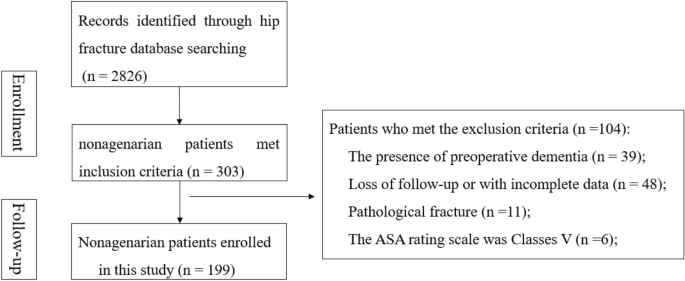
- Select a language for the TTS:
- UK English Female
- UK English Male
- US English Female
- US English Male
- Australian Female
- Australian Male
- Language selected: (auto detect) - EN
Play all audios:
Hip fractures in nonagenarians is one of the great challenges for patients of this age, the family and the larger society. The purpose of this study was to investigate the risk factors and
prognosis of postoperative delirium in nonagenarians with hip fracture. 199 Eligible patients were enrolled. Confusion Assessment Method (CAM) were used to identify the delirium. Logistic
regressions were used to investigate the effect of 18 pre-existing conditions on postoperative delirium. Prognosis of postoperative delirium in nonagenarians with hip fracture were also be
evaluated. The results indicated the following: (1) the prevalence of postoperative delirium among nonagenarians with hip fracture was 28.1% (56 of 199); (2) coexisting disease ≥ 4 (OR =
5.355, 95% CI = 1.394–9.074, P = 0.007), longer admission to operating time (OR = 1.514, 95% CI = 1.247–1.837, P = 0.000), and general anesthesia (OR = 2.086, 95% CI = 1.804–7.968, P =
0.032) were independent risk factors for postoperative delirium in nonagenarians with hip fracture; (3) nonagenarians with postoperative delirium had a predominantly high burden of
perioperative complications, long length of stay, and postoperative mortality at 30 days follow-up and 1 year follow-up than the patients without postoperative delirium. The results could
enable clinicians to improve outcome after operation in nonagenarians with hip fracture.
Delirium, characterized by a change in mental status, loss of cognitive and perceptive functions, and alterations in the sleep cycle, is a common complication in patients with hip fracture1.
The reported prevalence of postsurgical delirium after hip fracture ranged from 28 to 61%2. Postsurgical delirium is associated with greater morbidity and mortality, longer length of
hospital stays, and higher rates of institutionalization, and has been suggested as significant predictor of poor prognosis in hip fracture patients3,4,5. Predisposing factors, including
dementia, underlying comorbidity, and precipitating events (including major trauma and anesthesia) play an important role in the occurrence of delirium. Identifying the predisposing factors
is critical for risk stratification for postsurgical delirium among the elderly hip fracture. Further, a complex intervention the preventable risk factors would enable clinicians to achieve
the maximum favorable outcome for patients with hip fracture.
China has the largest population in the world and is facing population aging; as a result, the risk of hip fractures increases, in particular in nonagenarians6. Nonagenarians with hip
fractures are different from younger hip fracture patients. In one study, the group of nonagenarians with hip fracture was with more women patients, higher prevalence of heart disease, lower
prevalence of COPD and diabetes than younger patients with hip fracture7. A recent study reported that patients older than 90 years with hip fractures had higher mortality rates per year
than younger patients8. Baseline functional status was poorer among the nonagenarians. The prevalence of independent for transferring from bed to chair before the fracture varied between 50
and 70% depending on the different countries and districts7. In addition, medical complications after hip fracture, such as delirium, had been found more frequently in nonagenarian patients
with hip fracture during their hospital stay9. Due to the reasons above, nonagenarians with hip fracture are often excluded from clinical trials. Therefore, research on hip fractures in
nonagenarians highlights the urgent need for management of this subgroup, and is of great challenges to the patients, the family and the larger society.
The purpose of this report was (i) to find the prevalence of postoperative delirium in nonagenarians with hip fracture; (ii) to find which variables can predict postoperative delirium in
nonagenarians with hip fracture; (iii) to find prognosis of postoperative delirium in nonagenarian patients with hip fracture.
We performed a retrospective analysis of demographic, clinical, and delirium data in consecutive hip fracture patients at the Department of Orthopedics, the Seventh Medical Center of
People’s Liberation Army, between January 2012 and December 2020. This study was approved by the Seventh Medical Center of People’s Liberation Army Institutional Review Board, all methods
were carried out in accordance with relevant guidelines and regulations. And the patients or their family gave informed consent to use their data. Data including age, gender, past medical
history (hypertension, coronary heart disease, diabetes mellitus, chronic obstructive pulmonary diseases, lung infection, stroke, and renal insufficiency), post-injury factors (admission to
operating time, fracture type, white blood cell count, hemoglobin, and albumin), surgery related factors (type of anesthesia, amount of blood transfusion, and surgical method), delirium
(time of occurrence and duration), and length of stay were obtained by reviewing their medical records. Routine follow-up visits were scheduled at 30 days and 1 year after surgery. Mortality
outcomes of inpatients using the date of death were obtained from the medical records. Mortality status and walking ability at 1 year follow-up were performed by using hospital records
and/or phoning the patient’s family by a dedicated person.
Participants who met the following inclusion criteria were included: (1) were aged ≥ 90 years; (2) walk independently or with the aid of tools before injury; (3) intertrochanteric fracture
or femoral neck fracture; (4) low energy damage (a fall from standing height or lower); (5) treated surgically for single hip fracture.
Participants were excluded if they met any of the following criteria: (1) the presence of preoperative dementia; (2) pathological fracture; (3) the American Society of Anesthesiologists
(ASA) rating scale was Classes V; (4) refused follow-up after discharge or with incomplete data.
Each patient was identified by two senior orthopedists and fulfilled the criteria above.
The following assessments were all performed at the Seventh Medical Center of People’s Liberation Army.
The most widely used instrument for identification of delirium is the Confusion Assessment Method (CAM)10,11. CAM scores are determined by four features: (1) acute onset and fluctuating
changes in mental status, (2) inattention, (3) disorganized or incoherent thinking, and (4) an altered level of consciousness. The diagnosis of delirium by CAM requires the presence of
features (1) and (2) and either feature (3) or (4). After surgery, delirium based on CAM was assessed daily, and the enrolled patients were divided into delirium group and delirium-free
group. Because of difficulty in identifying true delirium and the residual effects of anesthesia, assessment of delirium on the day of surgery was excepted.
The presence of preoperative cognitive impairment/dementia was determined within 24 h of admission using the Mini-Mental State Examination (MMSE). The scores ranged from 0 to 30, with higher
scores indicating higher cognitive function. Normal mental status was defined as a MMSE score of 25 points or more (maximum score is 30).
Walking ability at 1 year follow-up were categories into independent (independent community or household ambulator), dependent (patient with a minimum level of mobility) and not walking
(nonambulator).
After preoperative examination, assessment and prepare for surgery, surgical treatment was given as soon as possible according to the type of fracture. Patients with Garden type I and II
femoral neck fracture had been treated with cancellous screws. Patients with Garden type III and IV femoral neck fracture underwent hip arthoplasty. Sliding hip screw (SHS) and
intramedullary nail were allocated to the treatment of stable intertrochanteric (A1, A2.1) and unstable intertrochanteric (A2.2, A2.3, A3), respectively. Different rehabilitation programs
were applied to postoperative patients by specialized rehabilitation therapist according to different fracture sites and treatments. The follow-up was performed by a dedicated person over
the phone who were blinded to the grouping situation at 30 day and 1 year after surgery.
We obtained data on a wide range of factors that might contribute to delirium in patients after hip fracture surgery. 18 variables were grouped into the following categories:(1)
sociodemographic data (age and gender; n = 2 variables), (2) past medical history (hypertension, coronary heart disease, diabetes mellitus, chronic obstructive pulmonary diseases, lung
infection, stroke, and renal insufficiency, and number of comorbidities; n = 8 variables), (3) post-injury factors (admission to operating time, fracture type, white blood cell count,
hemoglobin, and albumin; n = 5 variables), and (4) surgery related factors ( anesthesia, surgical approach, and amount of blood transfusion; n = 3 variables).
There were three kinds of variables in this model. Continuous variables: age, admission to operating time, white blood cell count, hemoglobin, amount of blood transfusion, and albumin.
Dichotomous variables: gender, fracture type, anesthesia, hypertension, coronary heart disease, diabetes mellitus, chronic obstructive pulmonary diseases, lung infection, stroke, renal
insufficiency, and number of comorbidities(≥ 4 or








